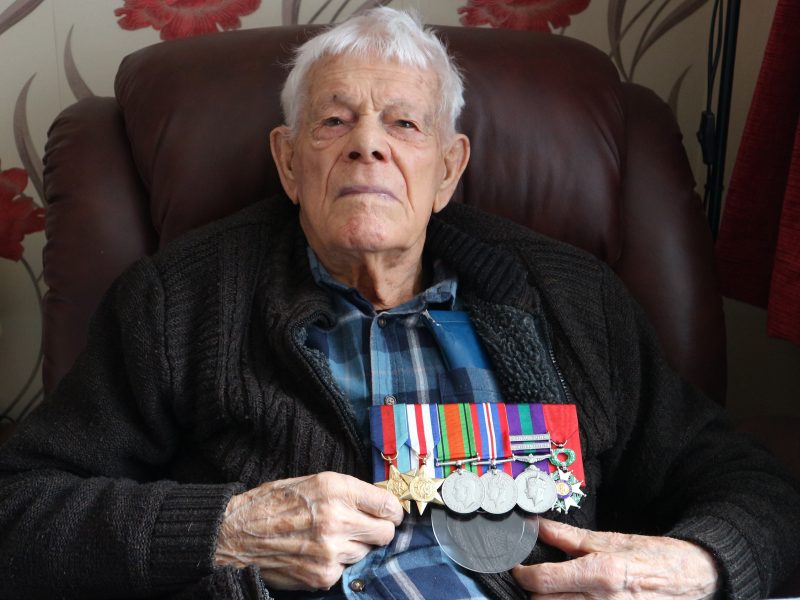AS communities across the country prepare to mark the 80th anniversary of VE Day, the Voice met one of the last surviving South Gloucestershire Second World War veterans who fought in Germany in May 1945.
ASK Leonard Trewin where he was on VE Day – May 8, 1945 – and he can give you the answer in a flash.
“I remember it all well,” he says. “We were at Wismar on the Baltic, trying to keep the Russians out!”
Len is 100 now. His hearing isn’t what it used to be, he isn’t very mobile and dementia has affected parts of his memory.
But there are still some events that are etched in his mind, from seeing action for the first time during the Battle of Normandy in 1944 to meeting his German wife-to-be at a labour camp liberated by his battalion.
Len also carries a permanent reminder of the war, in the form of a piece of shrapnel lodged above his left eye, which has remained there for the last 80 years.
Born in Cornwall and brought up in Devon, Len volunteered for the Home Guard in 1940.
He was called up in 1943, aged 19, and trained with the 13th Warwickshire Regiment and the Devonshire Regiment before volunteering for parachute training.
Len first saw action in August 1944, when he joined the Battle of Normandy in Herouvillette as part of the 8th (Midlands) Parachute Battalion, 3rd Parachute Brigade, 6th Airborne Division.
He said: “We were reinforcements. We saw action straight away.
“That was three days before the break-out. We finished up by Le Havre.”
Len’s battalion returned to England in September but he and his comrades were called into action again in December, when they crossed the Channel on Christmas Day to take part in the Battle of the Bulge.
They helped to counter the German offensive in the Ardennes that had been launched to try and turn back the Allied advance.
“We went to get the Americans out of trouble,” Len says.
Joining the battle at Anhee on the River Meuse in Belgium, they advanced to Houyet and then Rochefort, as the Germans were finally pushed out of Belgium.
In January 1945 Len’s division moved into Holland, where his mortar section fired on German positions across the river Maas, before returning to England for training to take part in the Rhineland offensive.
On March 24 he was one of 16,000 paratroopers dropped onto German territory on the Eastern bank of the Rhine as part of Operation Varsity, the biggest and most successful airborne operation ever carried out on a single day at one location.
Len’s battalion was the first to land, near the village of Hamminkeln, with the aim of clearing the drop zone for the other troops.
He jumped with three mortar shells strapped to his legs.
A list of the 16 paratroopers in the Dakota aircraft with Len shows that one – a sergeant – refused to jump.
One was killed on the day of the drop and another was listed as missing, while two others were wounded, three weeks into the campaign.
Len himself was injured three days after the drop by a piece of shrapnel, which narrowly missed his eye.
He said: “We were going along the road and they were firing 20mm anti-aircraft guns at us.”
One of the rounds exploded and shrapnel pierced Len’s skin just below his eyebrow.
He was taken to a field hospital, where medics decided not to try and remove it and, after a night in the hospital, Len returned to his unit.
After the war he was asked if he wanted the shrapnel removed but he told doctors to leave it there.
Len said: “It’s not done me any harm – it’s been here long enough!”
Through the final weeks of the war, Len’s battalion fought through Osnabruck, Minden and Lubeck before reaching Wismar on the Baltic with the 11th Armoured Division, as the Allies raced to occupy German territory before the Nazi surrender.
It was while in Germany that Len met his wife Gerda, an inmate at a labour camp on Luneberg Heath, near Hamburg, that his battalion liberated.
Gerda had grown up in Braunschweig, or Brunswick, a city near Hanover.
Len said: “She was in a labour camp because she had refused to do war work in a munitions factory – there were lots of them that had refused.”
After VE Day Len expected to be deployed to the Far East but Japan’s surrender in August meant that he was instead sent to Palestine, then governed by Britain under a pre-war League of Nations mandate.
Len left the 8th Battalion in 1947 and was discharged from the Army that October, but rejoined the following month, serving in the Devonshire regiment and Parachute Regiment in Germany, Cyprus and Egypt until 1953.
Len and Gerda married after the war and raised a family of three sons at Lyndhurst and Fawley in Hampshire, where Len worked at the Esso oil refinery.
They moved to Yate in 2000 to be closer to son Mike and his wife Michelle, with whom Len now lives.
Gerda died in 2010.
In recent years, Len has received new honours for his wartime service.
He was made a knight of the French Legion D’Honneur in 2018, receiving his medal in June 2019 at an event to mark the 75th anniversary of D-Day.
He was invited to Ahnee in the Ardennes in 2023, when he was made an honorary citizen of the commune.
Having previously stopped attending commemoration events on the continent due to his age, Len went back after Mike offered to accompany him, and it was only then that he started talking to his son about his wartime service.
Closer to home, Yate retirement development Trewin Lodge was named in his honour in 2019.
He has recently been photographed in a replica Para uniform for the Standing With Giants project, which has produced banners to commemorate VE Day that will be displayed in public spaces across the country.
Len is the last surviving member of the 8th Battalion who took part in the Normandy and Ardennes campaign, and one of only two still alive from Operation Varsity.
He has been invited to one of the national VE Day celebrations in London on May 8 but because of the difficulties of attending an evening event in the capital, he and his family will instead have a party with neighbours outside their home in Yate, before attending a lamp-lighting event at the nearby QEII Memorial Garden in the evening.
People are being encouraged to attend events and take time to remember those like Len who fought for freedom, as well as those who never made it back home.
Len himself says it’s a matter of personal choice whether people take the time to remember.
He said: “It’s up to people – you can’t make people do what they don’t want to do.”
That, after all, was the point of going to war against the Nazis.
Len said: “It’s not for us to judge if it was worthwhile, but there would’ve been trouble if we didn’t do it – you couldn’t let Hitler have his way.”
VE Day events
A NUMBER of events have been organised across South Gloucestershire to mark the 80th anniversary of VE Day.
Those confirmed as the Voice went to print were:
VE Day celebration at St James Church, Mangotsfield on May 5, from 11am-4pm.
Games, arts and crafts for children, refreshments served all day.
Flag raising ceremony at Alec Large park at 1.45pm to inaugurate new flagpole.
Afternoon tea at the church from 2pm.
Beacon lighting at Siston Hill, organised by Siston Parish Council, from 6.30pm on May 8.
Fish and chips picnic from 6.30pm, followed by live music at 7.30pm.
Service with music at 8.45pm, with beacon lighting at 9.30pm.
Attendees are encouraged to wear wartime outfits and bring flags to wave.
Beacon lighting at Tyler’s Field, Yate from 6pm on May 8, including musical performances and a short service before the beacon is lit at 9.30pm.
Dodington Parish Council VE Day 80 Commemoration at QEII Memorial Garden, QEII Playing Fields, Rodford Way, Yate. May 8 from 9pm, with peace lamp lighting at 9.30pm.
Frampton Cotterell Parish Council VE Day 80 event, Centenary Field, Frampton Cotterell, May 8, 8pm-9.30pm.
The government has announced that all pubs will be allowed to open until 1am on the night of VE Day.
Details of VE Day events happening nationwide can be found online at ve-vjday80.gov.uk.


